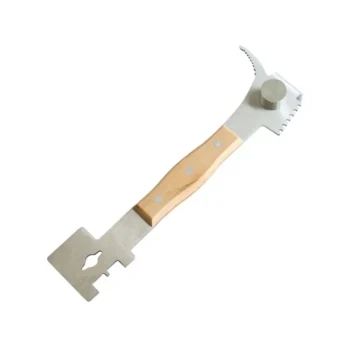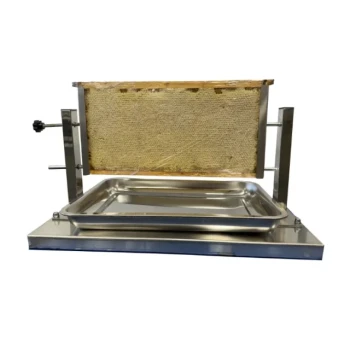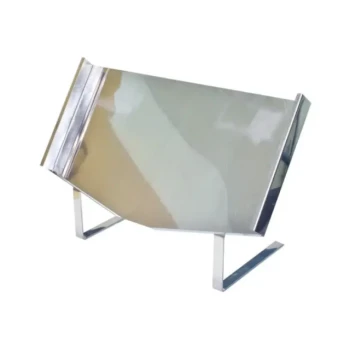At its core, a beehive stand protects a colony by elevating the hive off the ground. This simple change in elevation creates a significant physical barrier that makes it more difficult for ground-based predators and pests to access the hive entrance, giving the bees a critical defensive advantage.
A hive stand is not just a piece of furniture; it is a strategic tool that disrupts the natural attack patterns of common threats. By forcing predators into more vulnerable positions and denying easy access to pests, a stand fundamentally improves the colony's security and overall health.
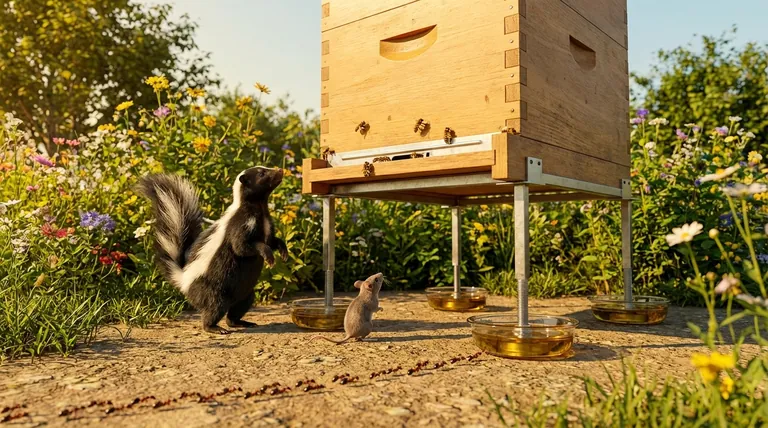
The Mechanics of Elevation as Defense
Raising a hive just 18 inches off the ground completely changes its relationship with the surrounding environment. This elevation creates specific challenges for the most common hive intruders.
Disrupting Ground-Level Predators
The most notorious ground predator for beehives is the skunk. A skunk's typical method of attack is to scratch at the hive entrance at night, luring guard bees out to be eaten one by one.
When a hive sits on the ground, a skunk can perform this action comfortably. However, an elevated hive forces the skunk to stand on its hind legs and expose its less-furry, vulnerable underbelly to the bees' stingers. This makes the attack far riskier and often deters the skunk entirely.
Denying Access to Opportunistic Pests
Mice are another significant threat, particularly in colder months. They seek warmth and a ready food source (honey and pollen) and can easily slip into a ground-level hive to build a nest for the winter, often destroying comb and contaminating the hive.
By placing the hive on a stand, you create a climbing challenge. While not impossible for a mouse to overcome, it makes the hive a much less convenient target compared to other available shelters, significantly reducing the likelihood of invasion.
Creating a Defensible Perimeter
For pests like ants and small hive beetles, a stand creates a crucial checkpoint. It funnels their approach up the legs of the stand, allowing the beekeeper to implement secondary defenses.
Placing the stand's legs in containers of oil or soapy water creates a moat that ants cannot cross. This simple trick, only possible with a stand, provides nearly foolproof protection against ant infestations.
Understanding the Trade-offs and Considerations
While a hive stand is almost always a good idea, its effectiveness depends on proper selection and setup. Simply elevating the hive is not enough if done incorrectly.
Height and Stability are Key
The ideal height for a hive stand is typically 18 to 24 inches. This is high enough to deter most ground predators but low and stable enough for the beekeeper to safely lift heavy boxes (supers) of honey without excessive strain.
A stand must be placed on level ground and be completely stable. A wobbly stand is a serious hazard, as it can be tipped over by wind, a clumsy animal, or the beekeeper, which can instantly destroy a colony.
It's One Part of a Larger System
A stand is a foundational piece of pest management, but not a complete solution on its own. It works best when combined with other protective measures.
For example, a stand will not stop mice if the hive entrance is large enough for them to enter. It must be paired with a mouse guard (a metal or wooden strip with bee-sized holes) during the fall and winter to provide complete protection.
Making the Right Choice for Your Goal
A hive stand is a multi-purpose tool that addresses security, hive health, and beekeeper comfort. Use your primary goal to guide your setup.
- If your primary focus is deterring skunks: Ensure your stand is at least 18 inches tall and stable enough to resist being pushed or knocked over.
- If your primary focus is preventing mice in winter: Combine a stand of any stable height with a correctly installed mouse guard at the hive entrance.
- If your primary focus is stopping ants: Select any stable stand and be prepared to place its legs in small containers of oil or water to create a protective moat.
- If your primary focus is your own comfort and ease of work: Choose a sturdy stand that raises the hive to a comfortable working height for your back, typically around 18-24 inches.
Ultimately, a proper hive stand is a foundational investment in the long-term security, health, and productivity of your colony.
Summary Table:
| Predator/Pest | How the Stand Protects | Key Takeaway |
|---|---|---|
| Skunks | Forces them to stand, exposing their vulnerable belly to bee stings. | Elevation of 18+ inches is a strong deterrent. |
| Mice | Creates a climbing challenge, making the hive a less convenient target. | Pair with a mouse guard for complete winter protection. |
| Ants & Small Hive Beetles | Funnels approach, allowing for secondary defenses like moats of oil/water. | Stand legs create a checkpoint for easy pest control. |
Secure Your Apiary's Foundation with HONESTBEE
A sturdy hive stand is the first line of defense for your valuable colonies. At HONESTBEE, we supply commercial apiaries and beekeeping equipment distributors with durable, wholesale-focused beekeeping supplies designed for maximum security and beekeeper efficiency. Protect your investment and promote colony health with equipment built to last.
Contact HONESTBEE today to discuss your wholesale needs and build a more secure, productive apiary.
Visual Guide
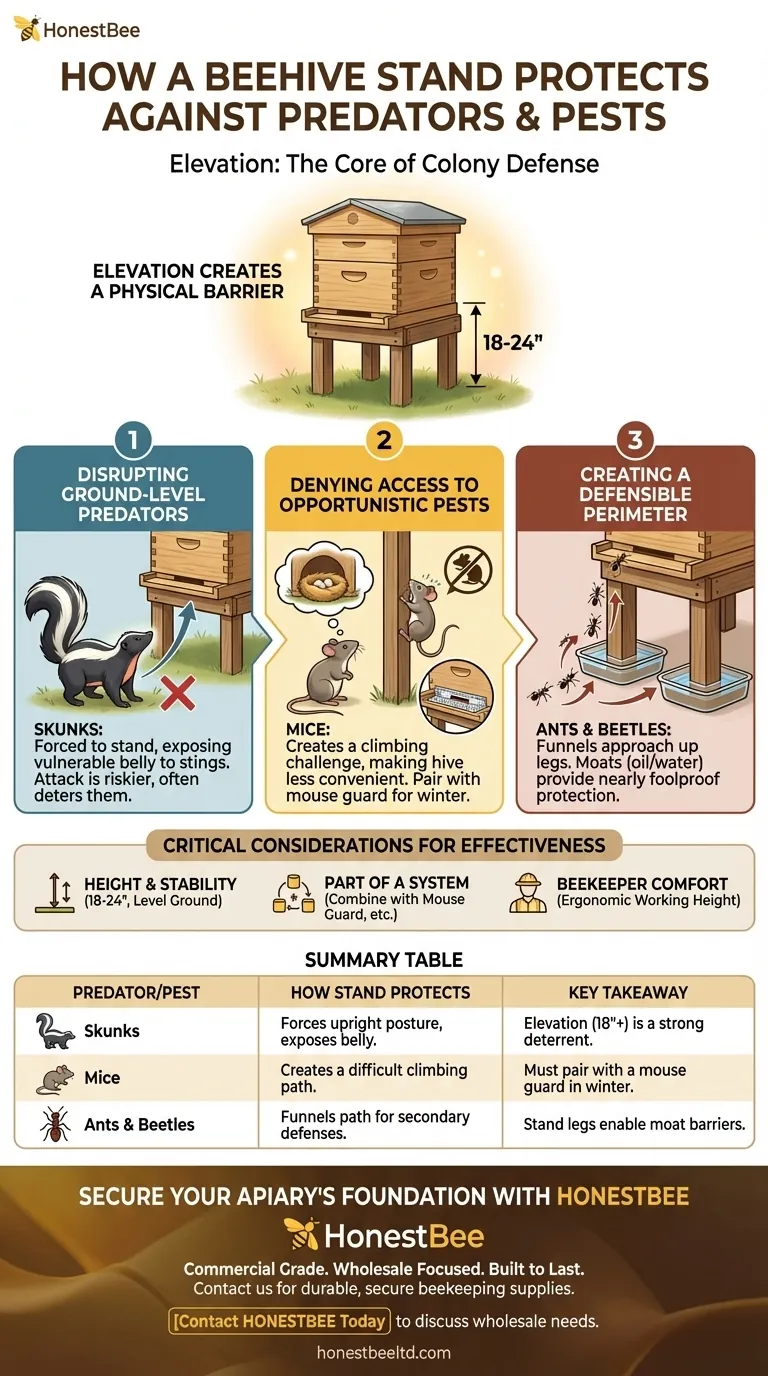
Related Products
- Metal Hive Feet Bee Hive Stand for Ant Protection
- Professional Engraved Round Hive Number Tags for Beekeeping
- Metal Bee Hive Stand Bee Box Stand for Beekeeping
- Plastic Bee Hive Stand for Beekeeping
- Wholesales Dadant Size Wooden Bee Hives for Beekeeping
People Also Ask
- How can hive stands be made more secure in windy areas? Anchor Your Apiary Against the Elements
- What factors should you consider when selecting a hive location? Ensure Your Bees Thrive from Day One
- What is the best stand for a beehive? A Practical Guide to Durability & Stability
- How do bees regulate the temperature of their hive during the summer? Discover Their Natural Cooling System
- Why is it important to keep a beehive dry? Ensure Colony Health and Hive Longevity






